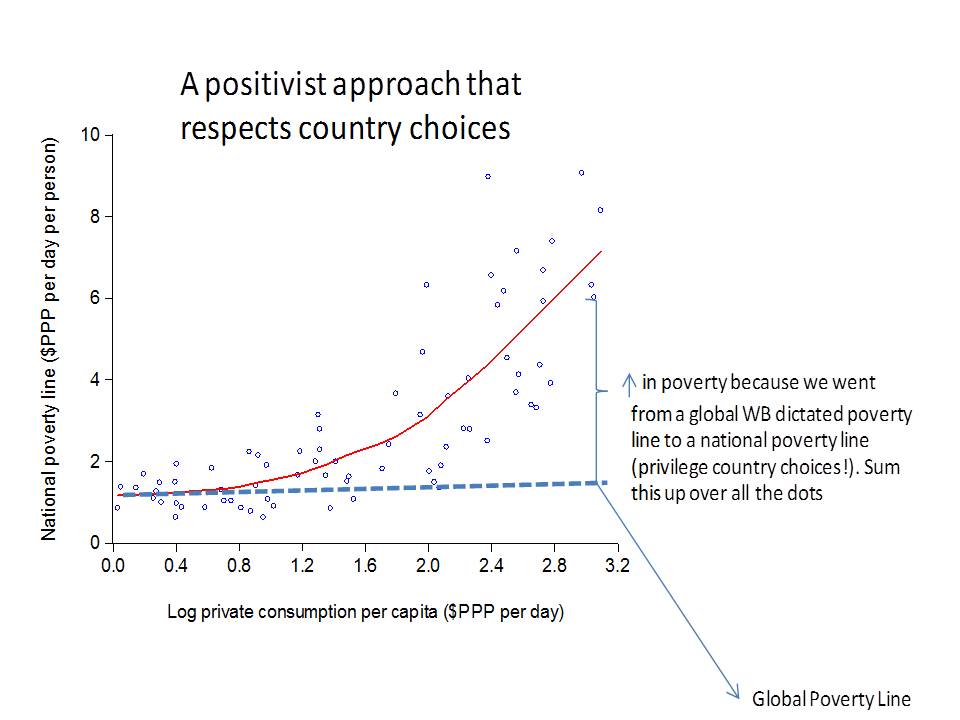This follows on part I posted earlier today – we choose to split the post into two because of length.
Part 2: What does Martin’s proposal imply?
Where do the differences between the absolute and the relative poverty measures come from? Because eventual discussions over a country's poverty numbers will be held with each country, the increased estimates may look like the WB is suddenly changing the goal post. Therefore, it is useful to think of the difference between absolute and global poverty as emerging from a two-part decomposition and an internal consistency requirement.
Step 1 in decomposing the difference: Step 1 uses national poverty lines rather than a global estimate of $1.25. In the figure below, the number of poor people in a rich country would have earlier been given by the number above the dotted line. But, the national poverty line is much higher as incomes increase, so in the rich countries, the absolute poverty line was bound to under-count the poor in contrast to poverty estimates based on each country's own poverty line. In a sense, this approach uses country norms in the determination of poverty.

Step 2 in decomposing the difference: Step 2 says that instead of using the actual poverty lines of each country, we believe that each country's poverty line should be the weighted average of poverty lines for countries at that level of income. So, in the figure below, we are going to decrease the number of poor in Country A by moving their poverty line down, and increase the number of poor Country B by moving their poverty line up. This seemingly normative choice, if viewed as a welfarist principle, can confuse the privileged notion of country norms in Step 1.
Martin’s take on this is significantly different, from my 2-way decomposition. His view is that the difference between national poverty lines can be used to identify the cost of social inclusion in determining a relative poverty line. Therefore, the fitted line does not over-ride national norms; that was never the intention. Instead, the national poverty norms are only used to estimate how social inclusion costs increase with average income. Of course, this continues to assume that the variation around the fitted line does not reflect differential costs of social norms across countries.
A natural question is why this should matter for global poverty estimates, since the errors should “balance” themselves out. But the errors balance themselves out in the poverty lines and not the numbers. Since the typical log-normal distribution is concave, for two countries that are equally far from the weighted average of poverty lines, one above and one below, increases in the poverty line for the country below will increase the number of poor more than the decrease in the poverty line for the country that was initially above (like in the figure on the right).
Step 3: The internal consistency requirement
The final step in this argument, required for forecasting, is that the estimated relationship—that is the “kinked” global relative poverty line will not change over time.
Part 3: What questions does this proposal raise?
Question 1: Greater transparency in explaining the difference?
People worry that this new exercise will fundamentally confuse the country dialogue by presenting a "new" Washington benchmark—a shifting goalpost. Is it better to present the difference between the absolute and relative poverty measures in terms of the two-way decomposition: increases because we move from the $1.25 to each country’s poverty line and increases because we move from country poverty lines to the weighted average?
Question 2: Why not just use national poverty lines?
Duncan Green’s blog carried an article a while back using national poverty lines to estimate poverty - thanks to Martin in pointing this out. This may be a well posed alternative to using the fitted line that Martin proposes. I, for one, remain confused about the theoretical underpinnings of first using country poverty norms to compute poverty and then assigning the weighted average to every country, regardless of whether this is used to identify the cost of social inclusion, or is an argument for using revealed choice more broadly.
I can see why this is necessary: By announcing that national poverty lines will be used, the incentives for setting poverty lines will change for many countries (for instance, those who want to continue receiving discounted IDA funds may increase the poverty line) and the new poverty lines will no longer be reliable indicators for country poverty norms. Using the weighted average guarantees that the ability of any one country to change the global poverty estimates goes down—and so does the incentive to fiddle around with it.
But, does doing so introduces its own problems?
First, the theoretical basis for using revealed choice data to compute the regression fit, but then discarding all the revealed choice data in favor of the regression fit is not clear, unless we are fully willing to model the variation along the fitted line as errors orthogonal to the societal notions of welfare. This is somewhat like using community-based targeting to identify the poor, but then using the fitted regression with incomes to again assess the poor. But community-based targeting may use fundamentally different measures that the researcher does not have access to. At the country-level, some modeling of where the “errors” relative to the fitted line come from could be useful. If, for instance, higher country norms for poverty relative to the fitted line arise because income is more variable, the implications are very different from (say) higher poverty lines because the society is less autocratic or because of pure measurement error.
Second, there was no information in the presentation on the stability of the function over time. Is there panel data on national poverty lines? If so, it would be nice to see evidence on the stability of this global poverty line. If it moves around, do we say that this latest version is “set in stone” for the global poverty lines?
Third, the WB itself may lead to additional changes in country norms because of Martin’s work. There was a bit of a funny exchange where an audience member suggested that this kind of analysis is very influential in changing the minds of policy makers. Why? Because it can—and is—being used to shame countries into increasing their poverty lines.
The incongruence between the stability of the function and the (very well intentioned) bank staff is fairly apparent. To the extent that they are successful, the function will move up over time (unless they are equally diligent in convincing countries with high poverty lines that they should lower them) and may perhaps ultimately represent the line among the highest dots. Again, is the version presented here “set in stone” or will it move as countries are “convinced” to increase their own poverty lines?
Question 3: Violations of Sub-Group Anonymity
Any headcount of poverty violates some variant of the transfer axiom (money from the richer to the poorer should weakly decrease poverty) because money from someone just above the poverty line to someone way below could increase poverty. In addition the global relative poverty line also violates an anonymity requirement, because the (geographical) identity of the person transferring or receiving money really matters. If someone who is doing OK in a richer country (with a higher relative poverty line) gives money to a starving Indian, poverty may well go up, but if someone with the same income in a somewhat poorer country (with a lower relative poverty line) gives the same transfer to the same Indian, poverty may well decrease!
This has fundamental implications for migration and trade. Someone who migrates from Poland to Spain (with a lower relative poverty line) and enjoys an increase in wages will decrease global poverty, but if a similar person migrates from Mexico to the US (with a higher relative poverty line) and enjoys the same increase in wages, global poverty will go up! Fundamentally, poverty is now completely tied to geographical location rather than the global distribution of incomes. Again, this may be desirable since migrating to a higher-income location may require a larger basket of goods for the person to enjoy the social inclusion benefits of living in that country, but the geographic tying of poverty is worth a fuller discussion.



Join the Conversation